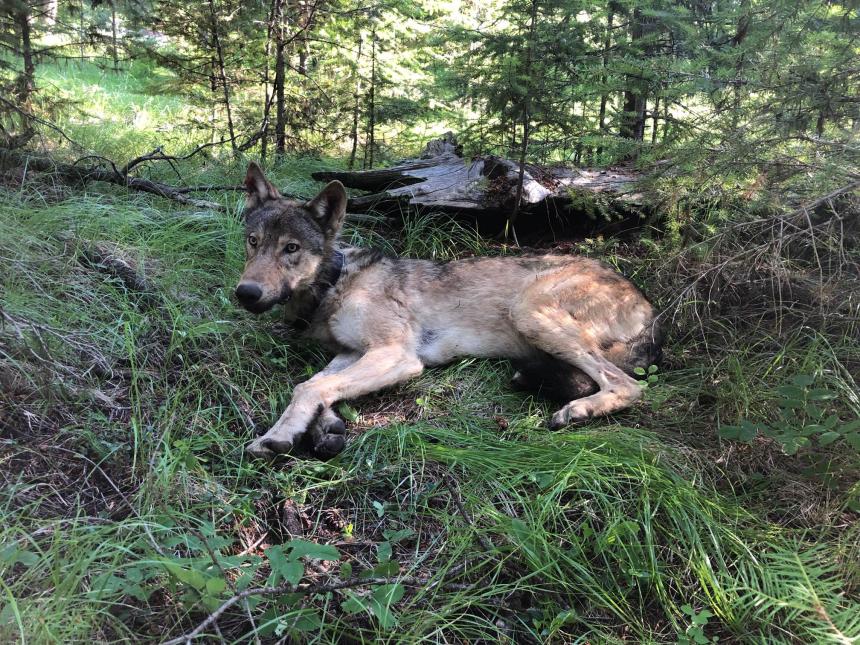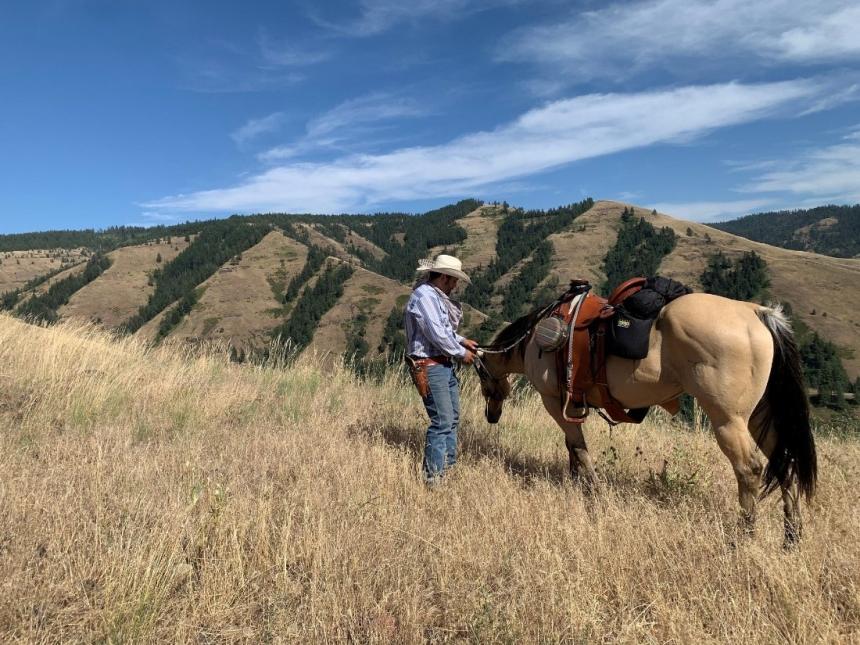This update provides an overview of gray wolf conservation and management activities in Washington during July 2022.
Program updates and coordination
- WDFW staff continued collaboration this month with the Utah State Range Rider Project. A team including WDFW staff and the Northeast Washington Wolf Cattle Collaborative fitted VHF ear tags on two herds of cattle to test how using telemetry to locate cattle may improve a rider’s overall effectiveness. Project personnel met with riders from various collaboratives and state agencies to train everyone on data collection for the project, and to coordinate rider efforts across Washington State. Over 140 trail cameras were deployed in Washington and Montana as part of this study.
- WDFW reminds the public that any individual killing a wolf caught in the act of attacking domestic animals must:
- report the incident to WDFW within twenty-four hours;
- grant or assist WDFW in gaining access to the property where the wolf was killed for the purposes of data collection or incident investigation; and
- surrender the wolf carcass to WDFW.
- If WDFW finds that a private citizen killed a wolf that was not attacking a domestic animal, or that the killing was not consistent with this rule, then that person may be prosecuted for unlawful taking of endangered wildlife under RCW 77.15.120.
- Please note that the “caught in the act” provision (section 1) of WAC 220-440-080 only applies to the area of the state where the gray wolf is not listed as endangered or threatened under the federal Endangered Species Act (the eastern one-third of Washington), and is not available in the western two-thirds of Washington.
Current population status and proactive conflict mitigation
The year-end minimum population count for 2021 was at least 206 known wolves in 33 known packs including at least 19 breeding pairs. Annual wolf population surveys are conducted in the winter because wolf populations experience the least amount of natural fluctuation during this time. Counting the population at the end of each year allows for comparable year-to-year trends at a time of year when the wolf population is most stable. The year-end minimum population count for 2022 will be released in April 2023.
Reports of remote camera images or videos, wolf tracks, or sightings from the public are extremely helpful in locating previously undocumented wolf activity and potential new packs on the landscape. Please take photos of wolves or wolf sign (use some way to measure the size of a track) and upload them to the wolf reporting page via the following link: https://wdfw.wa.gov/species-habitats/at-risk/species-recovery/gray-wolf/observations
Definitions: A “pack” is defined as two or more wolves traveling together in winter, and a “breeding pair” is defined as at least one adult male and one adult female wolf that raised at least two pups that survived until December 31. In any given year, the number of packs will always be greater than or equal to the number of breeding pairs. The known territories and more information for each pack can be viewed by clicking the pack name.
Beaver Creek pack
A WDFW wolf biologist captured and collared an adult male wolf in the Beaver Creek pack this month.

Butte Creek pack
No activity to report.
Carpenter Ridge pack
No activity to report.
Columbia pack
Following difficulties contracting range riders in the Blue Mountains area last year due to ongoing labor shortages in southeast Washington, WDFW staff worked diligently to contract range riders for this area of the state for 2022. WDFW recently onboarded a contracted range rider and subcontractor to work primarily in the Columbia pack territory. Routes to access some of the private pasture pieces remain a challenge due to adjacent easement restrictions. Department staff and contracted range riders continue to work with landowners and livestock producers to secure additional private property access points.

Dirty Shirt pack
No activity to report.
Dominion pack
No activity to report.
Goodman Meadows pack
No activity to report.
Grouse Flats pack
No activity to report.
Huckleberry pack
WDFW was informed that a wolf was killed on private property in Stevens County in a “caught-in-the-act” scenario on July 5. The incident was investigated by WDFW law enforcement the following day. The adult male wolf was interacting with a livestock guardian dog in a private sheep grazing pasture when it was shot.
Leadpoint pack
No activity to report.
Lookout pack
No activity to report.
Loup Loup pack
No activity to report.
Navarre pack
A WDFW wolf biologist maintained trail cameras in this pack territory.
Onion Creek pack
No activity to report.
Salmo pack
No activity to report.
Shady Pass pack
No activity to report.
Sherman pack
A WDFW wolf biologist trapped in this pack territory this past month but did not capture a wolf on this attempt.
Skookum pack
No activity to report.
Smackout pack
No activity to report.
Stranger pack
WDFW was informed that a wolf was killed on private property in Stevens County in a “caught-in-the-act” scenario on July 27 at approximately 9:00 p.m. The incident was investigated by WDFW law enforcement the following day. The adult female wolf was pursuing cows and calves on private land when it was shot. WDFW staff investigated an injured calf owned by this livestock producer and the evidence was consistent with a probable wolf depredation.
Sullivan Creek pack
No activity to report.
Teanaway pack
A WDFW wolf biologist maintained trail cameras in this pack territory.
Togo pack
On July 15, WDFW was informed that a range rider shot at a wolf chasing cattle in the Togo pack territory at approximately 9:00 p.m. the previous evening. The range rider was not sure if they hit the wolf. WDFW law enforcement investigated the incident and did not find evidence of a dead wolf, but did find wolf tracks and cow tracks in close proximity. WDFW law enforcement determined this incident was a “caught-in-the-act” scenario under WAC 220-440-080.
As of this update, WDFW has not documented deceased wolves from this incident or any wolf depredations in the Togo pack territory since June 12.
Touchet pack
WDFW staff searched for wolf presence and activity centers in this pack territory.
Tucannon pack
No activity to report.
Vulcan pack
No activity to report.
Wedge pack
WDFW wolf biologists monitored wolf activity within this territory.
Miscellaneous/lone wolves
WDFW staff continued to monitor a collared dispersing male wolf (originally from the Naneum pack) and an uncollared wolf (unknown age and sex) traveling in Yakima and Klickitat counties.
Biologists deployed cameras in areas south of I-90 to try to locate wolves that might be moving through or establishing pack territories in this area. A biologist also deployed cameras north of I-90 in areas outside of known wolf territories to try to locate potential new packs establishing. Biologists also surveyed for wolf activity in portions of Northeast and Northcentral Washington outside of known wolf territories.
Note: The Frosty, Nason, Nc’icn, Keller Ridge, Strawberry, and Whitestone pack territories are within Confederated Tribes of the Colville Reservation (CTCR) lands and are managed under tribal authority. Information regarding these packs is proprietary and reported at the discretion of the CTCR.
Mortalities
As noted above, an adult male wolf belonging to the Huckleberry pack and an adult female wolf belonging to the Stranger pack were killed in “caught-in-the-act” scenarios this month.
As of this update, in addition to mortalities under active investigation, WDFW has documented six wolf mortalities in 2022.
Depredation activity
Please report any suspected livestock depredations or the death or harassment of wolves to the WDFW Enforcement Hotline at 1-877-933-9847.
In 2021, 76% of known wolf packs were not involved in any documented livestock depredation.
Below is a summary of packs with documented depredation activity within the past ten months (some packs have depredation history prior to the current ten-month window; this timeframe is considered based on guidance from the wolf-livestock interaction protocol (PDF)).
|
Pack |
Depredation date |
Depredation type |
Proactive non-lethals |
Ten-month window |
Agency lethal removal actions |
|
Beaver Creek |
9/5/21 |
Probable mortality of calf |
No |
7/5/22 |
|
|
Columbia |
9/13/21 |
Confirmed mortality of calf |
Yes |
7/13/22 |
|
|
|
10/16/21 |
Confirmed injury of calf |
Yes |
8/16/22 |
|
|
|
11/1/21 |
Confirmed injury of one calf, probable injury of two calves |
Yes |
9/1/22 |
|
|
|
11/15/21 |
Confirmed mortality of calf |
Yes |
9/15/22 |
Adult male lethally removed 11/18/21; juvenile male lethally removed under authorized permit on 12/8/21 |
|
Lookout |
5/20/22 |
Confirmed mortality of two lambs |
Yes |
3/20/23 |
|
|
Stranger |
7/28/22 |
Probable injury of calf |
No |
5/28/23 |
|
|
Teanaway |
11/8/21 |
Confirmed injury of calf |
Yes |
9/8/22 |
|
|
Togo |
5/17/22 |
Confirmed mortality of calf |
Yes |
3/17/23 |
|
|
|
5/18/22 |
Confirmed injury of calf |
Yes |
3/18/23 |
|
|
|
6/8/22 |
Confirmed mortality of calf |
Yes |
4/8/23 |
|
|
|
6/12/22 |
Confirmed injury of calf |
Yes |
4/11/23 |
Yearling female lethally removed 6/14/22; adult male lethally removed 6/17/22 |
|
Vulcan |
4/30/22 |
Confirmed mortality of calf |
Yes |
2/28/23 |
|